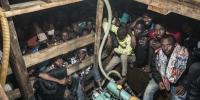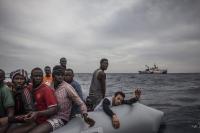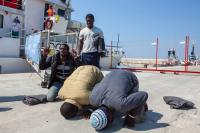Much ink has been spilt trying to make sense of the migration flow across the Mediterranean, a stretch of sea that has become the frontline of capitalism’s most urgent question: What’s more valuable – a human life, or the fraying concept of the sanctity of state borders?
By Nanjala Nyabola, Nairobi-based writer and political analyst.
Journalists and commentators have largely framed the boat crossings as a European crisis, and yet the vast majority of the migrants using the major route from Libya to Italy are Africans. They are also the majority of the nearly 2,000 people recorded ( http://www.iom.int/news/mediterranean-migrant-arrivals-reach-81292-2017-... ) to have died or gone missing in the Mediterranean so far this year.
Why do young Africans choose to risk all for the attainment of a precarious existence in Europe? Why is Africa home to me, but uninhabitable to my peers?
I went to Palermo, the largest city on the Italian island of Sicily, to try to get some answers.
Broken
The day I visit Palermo’s docks, volunteers anxiously await the arrival of a commercial vessel – the Tuna I – that has just rescued 470 people from the sea and is heading to port.
The energy is a little unnerving. It’s heartening to see so many people give up their time to welcome the people who have been rescued, but when the boat arrives many volunteers take selfies in front of the hungry and disoriented people hanging listlessly over the railing of the ship.
While the volunteers scream and wave their welcome to the Tuna I, the response from the ship is far less enthusiastic. There’s something perverse about this, consistent with the voyeurism that has characterised the global response to the drownings at sea.
Most of the people who disembark the Tuna I are clearly broken in ways I may never truly understand. Many weep or struggle to walk. Some have to be carried off.
Their clothes are ripped and worn, and almost none are wearing shoes. Almost none. A few stand out: An Arab man in shoes and socks is quickly cornered by the police.
There is damage here beyond the physical. Many look but don’t seem to see, moving among the volunteers as if in a trance.
Where did they break? Who hurt them?
At a halfway house in the suburbs of Palermo, I ask a group of young people who survived the same journey months earlier. They all give the same answer: Libya.
The devil and the deep blue sea
“Libya is not good. A person can’t live there. Africans are nothing to them [in Libya],” says Amir from Senegal. “[But] you can’t turn back once you’re in Libya, even if it’s not easy to come here.”
Everyone is scarred by Libya. Mention the name and eyes well up. In many ways, the reaction gets to the heart of what I went to Italy to engage with – what drives the momentum towards Europe, even when the journey becomes grotesque.
It turns out that once people are in Libya, going back is not an option. Libya is the devil to the Mediterranean’s deep blue sea.
Yet under Muammar Gaddafi, Libya was a prized destination in itself for Africans from throughout the region, a place of well-paid employment. Gaddafi’s removal in 2011, helped by a European-led coalition, changed that.
For black Africans, Libya has gone from haven to hellhole in the shadow of the bloody conflict and political vacuum that followed Gaddafi’s death. Africans have been crossing through Libya for decades, but there is a tinge of vengeful anti-blackness in the horrors they survive today.
Slave markets ( https://www.theguardian.com/world/2017/apr/10/libya-public-slave-auction... ) where black bodies are displayed and bartered are popping up in Libyan towns. Many people testify to being held in dark, windowless rooms, sometimes for months on end, while waiting for relatives to pay ransoms to facilitate their crossing.
Young women will almost certainly be raped, and it is not uncommon for people to be shot for complaining about any aspect of their detention.
When I ask Amir why he didn’t just turn back once he got to Libya, he says: “Whatever I saw in Libya was worse than anything I have ever seen in my life. And the thought of going back to Libya – back to the desert – was enough to keep me going.”
No home from home
But Italy offers only a meagre respite from racism.
“I have faced many difficulties,” I hear from Boubacar, a young Gambian. “I don’t have my independence like I want to.
“To me it’s not worth leaving my home and coming to a place like this to be discriminated [against], to be insulted, to be isolated.”
Italy does more than most for Africans who survive the crossing, but it is less than a full life with few prospects of becoming home.
The people who disembark the Tuna I get a pair of shoes, a bag with food, and a medical check-up. But they will almost immediately be shipped to reception centres around the country for interviews, and many will be deported. Only minors qualify for a substantive, automatic protection of two years.
Any services provided at the dock are primarily provided by non-profit organisations like the Red Cross. European governments deliberately punish survivors by withholding key services to make a point to anyone else considering the journey.
But national policies don’t always capture what’s happening on the ground. Local politicians like popular Palermo mayor Leonluca Orlando, who insists that diversity fuels the vibrancy and success of his city, resist Brussels.
“In 50 years, I am convinced that current European leaders will be facing charges of crimes against humanity,” Orlando tells me, as he personally greets some of the people disembarking from the Tuna I.
Palermo’s lessons
A popular narrative in European capitals is that if there was less migration there would be more opportunities for Europeans. But people in places like Sicily see things with more nuance.
Orlando’s welcome of rescue boats – he welcomes each one – has not dented his popularity in Palermo, even though Sicily is one of Italy’s poorest regions.
That’s partly because of a demographic crisis – Sicilians are producing fewer children. So, the subsidised labour of migrants has become invaluable.
At the Centro Astalli, a one-stop service centre for migrants and refugees in a disused church, I meet Veronica who provides a personal insight into the situation in Sicily.
The conversation begins as an introduction to the centre. But as soon as we realise we are the same age, it becomes a familiar millennial exchange on how much harder it is to attain conventional markers of success today than it was for our parents.
“I started here as a volunteer,” she tells me, “but when we got funding to expand the project they took me on full time. But my sister is 28, and she graduated almost three years ago and still hasn’t found work.”
Astalli offers one year of free Italian lessons, access to a laundry and showers, a free breakfast and afterschool activities for children. The centre also runs an arts programme with local volunteers that brings together Italians and migrants in projects designed to foster assimilation and understanding.
The programmes are funded by the Jesuit Refugee Services and the European Union. But some Palermitanos resent that so much is available to migrants for free.
“For me, I understand because I work here,” Veronica says. “Many of the asylum seekers are my friends. But for people like my sister, it’s very difficult to understand.”
“Why do they still come here when they know it’s so bad here?”
This leaves structural racism as an enormous challenge for Astalli’s clients. Asylum seekers find it impossible to rent houses or find meaningful work. Only one of Astalli’s clients to date has completed university.
A young Gambian man, like Seydou, who I met, would rarely experience the kindness that I experienced as a tourist with an American twang.
“Maybe no one is going to fight you on the streets, but when it comes to real integration we have many problems,” Veronika says. “The Sicilians will stay with the Sicilians, and the refugees together in another place, but they don’t mix.’’
It’s a dynamic that leaves many people like Seydou vulnerable to exploitation. He was forced to move when he threatened to report one of his first halfway houses for siphoning money from the municipality intended for supporting migrants.
“Why do they still come here when they know it’s so bad here?” Veronica wonders. It’s a question I put to the people I interview.
Seydou and the others tell me it’s about a chance at life – to escape a violent family or conflict, to being able to have optimism for the future.
None of the young people I encounter would encourage other Africans to attempt the crossing to Europe. But what European bureaucrats call pull factors, they call hope.
Cold war nostalgia
“Borders and barriers, which enclose us within the safety of familiar territory, can also become prisons and are often defended beyond reason or necessity,” wrote Edward Said in 1984.
The world then was paradoxically more and less open than it is today. On the one hand, in the shadow of empire, African and Asian citizens of various nationalities could travel to Europe and beyond without the burden of invasive, derogatory visa procedures.
For much of Africa, the Cold War opened Europe up in ways that may never be experienced again. The ideological blocs competed for influence by showering African students and technocrats with fully funded opportunities to work and travel.
In cities like Berlin, African students like my father could drink beer with their West German counterparts while East Germans like 20-year-old Michael Schmidt ( http://www.berliner-mauer-gedenkstaette.de/en/1984-329.html ) were shot dead for attempting to scale the wall.
African students had not yet felt the sting of authoritarianism or economic austerity at home. Struggling with racism in Europe, many treated their stay as a necessary, temporary step to professional achievement rather than a shot at staying.
Only after structural adjustment hollowed out African economies and the establishment of the new, hyper-connected European Union, did visa restrictions for non-Europeans become common. At first, they were simply administrative hurdles, but today they are laborious and dehumanising processes designed to deter all but the most tenacious.
New realities
Yet Europe still needs migrants, especially in the south where dwindling populations have aggravated labour shortages in agricultural sectors that resist mechanisation.
Italian grapes, Greek olives, and Spanish oranges all need bodies to plant, process and harvest them. By 1992, the architects of a single Europe realised that wealth disparities between various European countries – not just along the East-West axis but also North-South, the struggling economies of Greece, Italy, and Spain – required creative interventions for successful management.
“Borders and barriers, which enclose us within the safety of familiar territory, can also become prisons and are often defended beyond reason or necessity”
And so for much of the last 25 years, the Eurozone has both aggressively courted and turned away migrants: punishing people legally seeking asylum at airports and embassies, and more or less ignoring clandestine migration across the Mediterranean, until the European economy was pummelled by the 2007-2008 financial crisis.
Migration, or fear of migration, is today the bogeyman of European politics that might yet break up the European Union. Not because of the lie that a flood of refugees and migrants is on its way, but because of what Said observed: that the irrational and unnecessary over-policing of Europe’s borders is throwing up contradictions and triggering an existential crisis.
The impulse to keep people out at all costs leaves Europe with a paradox: While preaching humanitarianism abroad, politicians threaten to prosecute NGOs for saving migrant lives at sea because leaving people to die is considered a deterrence.
Europe is now trying to reconcile that gap with security-focused development aid. In late 2015, EU governments at the Valetta Summit ( http://www.irinnews.org/news/2015/11/12/eu-africa-migrant-plan-raises-wo... ) promised African governments, including autocratic regimes in Eritrea, Ethiopia, and Sudan, up to two billion euros in funding to help stem African migrations.
People move
After watching the Tuna I dock, I wander into some of Palermo’s museums and encounter three fascinating exhibitions.
The first is a tour that takes you past centuries-old churches with dome-shaped towers – mosques converted into Catholic churches and a testament to Palermo’s Muslim past.
The second is an installation at the museum of contemporary art featuring family photographs intertwined with yards of jute and rope. The artist set it up to evoke drowning, and perhaps the idea that – given a different set of circumstances – any one of our family members could have drowned trying to cross the sea.
The third is an exhibition at the Royal Palace featuring art from countries banned from the United States under President Donald Trump’s executive order.
These three exhibitions challenge Palermitanos to rethink simplistic narratives about migration. To me, they evoke the timelessness of human mobility, echoing Mayor Orlando’s vision that in 50 years the world may have a different set of moral values. Perhaps freedom of movement will be claimed as a universal value. Or perhaps it will be lost forever.
nn/oa/ks/ag
Aid and Policy Conflict Environment and Disasters Migration
Jason Florio/IRIN



